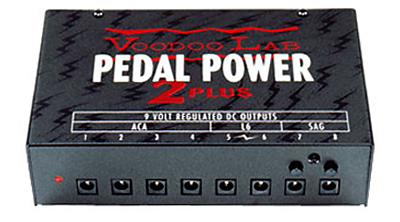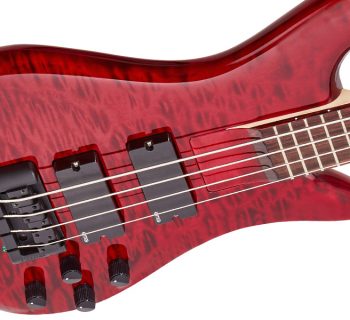Power. Your pedals need it, but they all seem to have their own special power requirements. Mix and match a few pedals from different manufacturers on the same power supply and find yourself confronting horrible electrical noise problems. Then throw into the mix a pedal with slightly different power requirements – some vintage pedals actually sounded better running off a dying battery than with a fresh nine-volt. And how about some classic pedals that ran off AC power only – no batteries at all! What to do?
| Category | Value | Rating |
| Features | 20% | |
| Usability | 25% | |
| Sound | 25% | |
| Documentation & Support | 10% | |
| Price | 20% | |
| OVERALL RATING = 3.4 3.6 stars or better: Outstanding, WIHO Award 3 stars or better: Worth considering 2 stars or better: Suited to specific needs 1 star or less: Not recommended |
||
Fortunately, the pedal builders at Voodoo Lab have given us the Pedal Power 2 Plus, an advanced power solution for pedal boards that can handle anything you want to throw at it. With support for up to nine devices, it’s quite a flexible product. It worked fabulously in our tests with a variety of pedals. You can reduce the power output on two of its eight power output jacks to simulate low battery conditions all the time, and we were able to connect a self-powered MIDI foot controller to the ninth connector – a grounded AC auxiliary jack.
Read the manual before using this power supply, though. Certain pedals must be connected to specific power jacks on the Pedal Power 2 Plus, and you may need to adjust dipswitches on the underside of the unit to increase power output for specific devices. Improper connection of your pedals could damage them.
There’s a reason you’ve been noticing this product on so many players’ pedal boards – if you mix and match a variety of old and new pedals from numerous makers, the Pedal Power 2 Plus gets the electrical job done simply and cleanly. We’re going to start using these on our pedal boards.
Features
The Pedal Power 2 Plus has eight DC output jacks, each providing nine volts of isolated and noise-filtered DC power.
Two of the output jacks have a recessed pot that you can adjust to lower the voltage for simulating low/weak battery conditions, ideal for use with some classic fuzz pedals. Power can be dropped to just over four volts.
An auxiliary grounded AC jack can accommodate up to 200W of power-sucking gear. You can’t plug an amplifier into this, but if you have a foot controller that lacks phantom power, or a hard-wired pedal like the famous TC Electronic SCF chorus/flanger pedal, you can attach it here.
The Pedal Power 2 Plus includes six standard-sized 3.5mm power cables, two smaller 2.5mm cables, one 1/8” mini-plug, and one battery snap for attaching to an old pedal that operated on battery power only.
Works with virtually every type of effect pedal ever made.
Our only gripe? The limited support for Boss Twin pedals and Line 6 Modeler pedals. You can only attach up to two of these pedals – two Twin pedals, two Modeler pedals, or one of each. But on the flip side, at least they have some support. Not all manufacturers of power supplies work with these popular devices.
Usability
Underneath the unit are a series of eight dipswitches, set to their Off state by default. Certain pedals can only be connected safely to specific jacks (to not damage the pedal), and in certain cases where a pedal draws slightly more than 9V of current, a dip switch must be set accordingly on the underside of the unit.
The Pedal Power 2 Plus is configured to support certain pedals only on specific power jacks. We created the reference chart below to help illustrate which pedals can be connected to which jacks.
|
MusicPlayers.com Pedal Power 2 Plus Connection Reference Chart
DIP Switch Settings (Off = default) |
||||||
|
Jack
|
Typical 9V Pedals
|
Standard Boss PSA
|
Boss Twin PSA
|
Boss ACA
|
Line 6 ToneCore
|
Line 6 Modeling
|
|
1
|
Off
|
Off
|
x
|
On
|
Off
|
x
|
|
2
|
Off
|
Off
|
x
|
On
|
Off
|
x
|
|
3
|
Off
|
Off
|
x
|
On
|
Off
|
x
|
|
4
|
Off
|
Off
|
x
|
On
|
Off
|
x
|
|
5
|
Off
|
Off
|
Off
|
x
|
Off
|
On
|
|
6
|
Off
|
Off
|
Off
|
x
|
Off
|
On
|
|
7
|
Off
|
Off
|
x
|
x
|
Off
|
x
|
|
8
|
Off
|
Off
|
x
|
x
|
Off
|
x
|
|
x = Cannot connect this type of pedal to this power jack.
|
||||||
Looking at the chart, you can see that if you own a Boss Twin pedal such as the DD-20 Digital Delay, it can only be attached to power jack 5 or 6. A Line 6 modeler such as the MM-4 Modulation Modeler pedal can also only be connected to power jacks 5 or 6, but you must also set the dipswitch for that jack to its On position.
Setting up a pedal board using the Pedal Power 2 Plus was simple enough once we figured out which pedals connected where. Because of the specific power and wiring considerations, you’ll want to plan out your pedal board requirements in advance to make sure that the Pedal Power 2 Plus can accommodate your needs.
Jacks 7 and 8 have potentiometers that we could reduce to drop voltage on those jacks in order to purposely create some SAG with vintage fuzz pedals that tend to sound better running on weak batteries than on new ones. The pots are recessed on the side of the unit and we didn’t have any problems with accidentally adjusting them.
The length of included cables was a bit challenging, though. The power supply cable for the Pedal Power 2 Plus unit was too short to be useful without an extension cord, but fortunately it is of the standard computer equipment variety and can be easily replaced at your local Radio Shack.
Additionally, we would have liked to see some longer power cables for pedals included with the product. With all connecting power cables of equal length – approximately 21” – it will be hard for some players to lay out their pedal boards without placing the Pedal Power 2 Plus in a central location on their board or without contacting Voodoo Lab to order longer power cables. We prefer a more spread-out arrangement on our pedal board, and with many players using larger pedals (double-width, for example), it can be hard to make everything fit with the included cables.
Sound
The Pedal Power 2 Plus scores great marks for making no sound at all! We connected an assortment of pedals from Boss (both traditional single pedals as well as a Twin), Line 6 (both PowerCore and Modeler varieties), Voodoo Lab, and Rocktron. Thanks to the independent, filtered power jacks for each pedal, we heard no electrical noise introduced by using the Pedal Power 2 Plus.
Anyone who ever tried connecting their Line 6 PowerCore pedal to the shared power supply in a Boss pedal board experienced unacceptable noise levels – that kind of a problem becomes a thing of the past with the Pedal Power 2 Plus.
Documentation and Product Support
The documentation for the Pedal Power 2 Plus is essential – it tells you about all of the wiring considerations and dipswitch settings, and it also provides some useful tips related to setting up your pedal board. But it’s a bit confusing to read which pedals require which settings and which jacks. After re-reading the manual a few times, we decided to create the handy reference chart listed above. If you use our reference chart, setting things up will be a breeze, and we welcome Voodoo Lab to incorporate our chart (or one just like it) into their product documentation.
Price
The Pedal Power 2 Plus (MSRP $239) sells for $170. We think it’s a good price given the feature set of this unit compared to similar offerings from other manufacturers.
Contact Information
Voodoo Lab
www.voodoolab.com
| Evaluation Short-List |
|

















